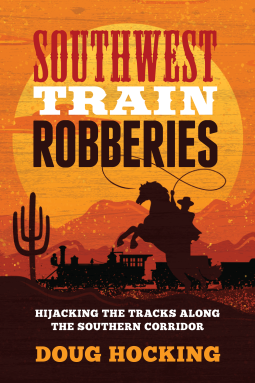Please wait... This may take a moment.
Southwest Train Robberies
Hijacking the Tracks along the Southern Corridor
This title was previously available on NetGalley and is now archived.
Pub Date
May 01 2023
| Archive Date
May 05 2023
Description
In 1854, the United States acquired the roughly 30,000-square-mile region of present-day southern Arizona and southwestern New Mexico from Mexico as part of the Gadsden Purchase. This new Southern Corridor was ideal for train routes from Texas to California, and soon tracks were laid for the Southern Pacific and Santa Fe rail lines. Shipping goods by train was more efficient, and for desperate outlaws and opportunistic lawmen, robbing trains was high-risk, high-reward.
The Southern Corridor was the location of sixteen train robberies between 1883 and 1922. It was also the homebase of cowboy-turned-outlaw Black Jack Ketchum’s High Five Gang. Most of these desperadoes rode the rails to Arizona’s Cochise County on the US-Mexico border where locals and lawmen alike hid them from discovery. Both Wyatt Earp and Texas John Slaughter tried to clean them out, but it took the Arizona Rangers to finish the job. It was a time and place where posses were as likely to get arrested as the bandits. Some of the Rangers and some of Slaughter’s deputies were train robbers. When rewards were offered there were often so many claimants that only the lawyers came out ahead.
Southwest Train Robberies chronicles the train heists throughout the region at the turn of the twentieth century, and the robbers who pulled off these train jobs with daring, deceit, and plain dumb luck! Many of these blundering outlaws escaped capture by baffling law enforcement. One outlaw crew had their own caboose, Number 44, and the railroad shipped them back and forth between Tucson and El Paso while they scouted locations. Legend says one gang disappeared into Colossal Cave to split the loot leaving the posse out front while they divided the cash and escaped out another entrance. The antics of these outlaws inspired Butch Cassidy and the Sundance Kid to blow up an express car and to run out guns blazing into the fire of a company of soldiers.
In 1854, the United States acquired the roughly 30,000-square-mile region of present-day southern Arizona and southwestern New Mexico from Mexico as part of the Gadsden Purchase. This new Southern...
Description
In 1854, the United States acquired the roughly 30,000-square-mile region of present-day southern Arizona and southwestern New Mexico from Mexico as part of the Gadsden Purchase. This new Southern Corridor was ideal for train routes from Texas to California, and soon tracks were laid for the Southern Pacific and Santa Fe rail lines. Shipping goods by train was more efficient, and for desperate outlaws and opportunistic lawmen, robbing trains was high-risk, high-reward.
The Southern Corridor was the location of sixteen train robberies between 1883 and 1922. It was also the homebase of cowboy-turned-outlaw Black Jack Ketchum’s High Five Gang. Most of these desperadoes rode the rails to Arizona’s Cochise County on the US-Mexico border where locals and lawmen alike hid them from discovery. Both Wyatt Earp and Texas John Slaughter tried to clean them out, but it took the Arizona Rangers to finish the job. It was a time and place where posses were as likely to get arrested as the bandits. Some of the Rangers and some of Slaughter’s deputies were train robbers. When rewards were offered there were often so many claimants that only the lawyers came out ahead.
Southwest Train Robberies chronicles the train heists throughout the region at the turn of the twentieth century, and the robbers who pulled off these train jobs with daring, deceit, and plain dumb luck! Many of these blundering outlaws escaped capture by baffling law enforcement. One outlaw crew had their own caboose, Number 44, and the railroad shipped them back and forth between Tucson and El Paso while they scouted locations. Legend says one gang disappeared into Colossal Cave to split the loot leaving the posse out front while they divided the cash and escaped out another entrance. The antics of these outlaws inspired Butch Cassidy and the Sundance Kid to blow up an express car and to run out guns blazing into the fire of a company of soldiers.
Available Editions
| EDITION |
Other Format |
| ISBN |
9781493071104 |
| PRICE |
$22.95 (USD)
|
| PAGES |
224
|
Available on NetGalley
NetGalley Shelf App
(PDF)
Send to Kindle (PDF)
Download (PDF)
Additional Information
Available Editions
| EDITION |
Other Format |
| ISBN |
9781493071104 |
| PRICE |
$22.95 (USD)
|
| PAGES |
224
|
Available on NetGalley
NetGalley Shelf App
(PDF)
Send to Kindle (PDF)
Download (PDF)
Average rating from 2 members




